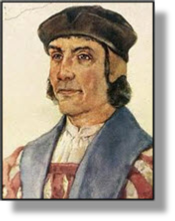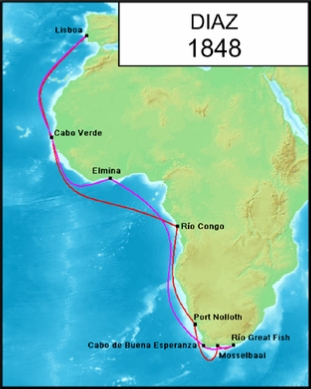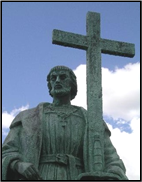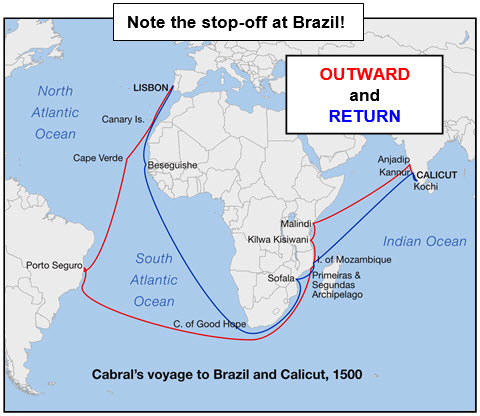


BARTOLOMEU DIAZ c1450 -
xxxxxAs we have seen, Henry the Navigator, having established his seafaring school at Sagres in 1419 (H5), played a large part in the exploration of the west coast of Africa. By his death in 1460 his navigators had reached as far as Sierra Leone. Later, in 1482, Diogo Cao sailed further south and discovered the mouth of the river Congo. He searched in vain, however, for a sea route to the east -

 xxxxxIt was in 1486 that King John II of Portugal appointed his able navigator Bartolomeu Diaz to continue the exploration of the west coast of Africa beyond the discoveries made by Diogo Cao. He sailed from Lisbon in August 1487 and in February 1488 became the first European to round the southern tip of Africa. It was a discovery of immense importance, opening up as it did the long sought-
xxxxxIt was in 1486 that King John II of Portugal appointed his able navigator Bartolomeu Diaz to continue the exploration of the west coast of Africa beyond the discoveries made by Diogo Cao. He sailed from Lisbon in August 1487 and in February 1488 became the first European to round the southern tip of Africa. It was a discovery of immense importance, opening up as it did the long sought-
xxxxxAn accomplished sailor, Diaz explored over 1200 miles of the African coastline -
xxxxxAs we have seen, having established his seafaring school at Sagres in 1419 (H5), Henry the Navigator sent expeditions south along the west coast of Africa. In 1482 Diogo Cao discovered the mouth of the River Congo, but it was left to Bartolomeu Diaz, appointed by King John II of Portugal, to become the first European to round the southern tip of Africa in 1488, thus opening the vital sea route from Europe to the Far East. He went on to the Great Fish River on the east coast of Africa before turning back. In 1497 he took part in Vasco da Gama's voyage to India -
Including:
Pedro
Cabral

xxxxxThe Portuguese navigator Pedro Cabral led an expedition to India in 1500 but, sailing too far west on leaving Lisbon, he first landed on the coast of Brazil and claimed this country for Portugal! In rounding the Cape of Good Hope he lost four ships with all hands, including Diaz, but eventually reached India and set up a trading post at Calicut. He returned to Lisbon in July 1501 after losing another five vessels.
 xxxxxThe Portuguese navigator Pedro Cabral (1460-
xxxxxThe Portuguese navigator Pedro Cabral (1460-
 xxxxxHe eventually reached India, where he called at a number of ports and set up a trading post at Calicut. This post was later destroyed by a large Muslim force, but before leaving for home he managed to negotiate a commercial agreement between Portugal and India, the first of its kind. He lost more ships on his return journey and arrived at Lisbon in July 1501 with only four out of his original fleet of thirteen vessels. A larger expedition to India was then organised with Cabral the likely commander, but after some kind of dispute, the appointment went to Vasco da Gama, and the man who claimed Brazil for Portugal went into retirement.
xxxxxHe eventually reached India, where he called at a number of ports and set up a trading post at Calicut. This post was later destroyed by a large Muslim force, but before leaving for home he managed to negotiate a commercial agreement between Portugal and India, the first of its kind. He lost more ships on his return journey and arrived at Lisbon in July 1501 with only four out of his original fleet of thirteen vessels. A larger expedition to India was then organised with Cabral the likely commander, but after some kind of dispute, the appointment went to Vasco da Gama, and the man who claimed Brazil for Portugal went into retirement.
xxxxxIncidentally, it is quite likely that the Spanish navigator Vicente Yáñez Pinzón, the youngest of three sea-
xxxxx…… As we shall see, in 1501 an expedition commanded by the Italian navigator Amerigo Vespucci was sent to Brazil, then named Terra da Vera Cruz (Land of the True Cross) by the Portuguese government. He named a number of physical features, including the bay he called Rio de Janeiro (River January). It was during this voyage that he became convinced that the coastline he was tracing was that of an entirely new continent. He returned with a cargo of brazilwood, and it was this valuable red wood (pau-



Acknowledgements
Map (Africa): licensed under Creative Commons. Author unknown – en.wikipedia.org. Diaz: date and artist unknown – private collection. Cabral: detail from a statue in his home town of Belmonte in central Portugal, date and artist unknown. Map (Africa): licensed under Creative Commons. Based on work by Castoro – en.wikipedia.org.
H7-